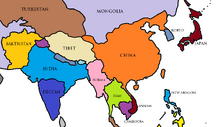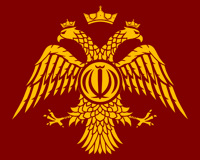| |||||
| Capital (and largest city) |
Nanjing | ||||
| Other cities | Beijing, Shanghai, Guangdong, Tianjin, Hanoi, Pyongyang | ||||
| Language official |
Mandarin Chinese | ||||
| others | Korean, Vietnamese, other Chinese dialects | ||||
| Demonym | Chinese | ||||
| Government | Constitutional monarchy | ||||
| Emperor | Tangzhi | ||||
| Prime Minister | Liu Yandong | ||||
| Area | 6,500,000 km² | ||||
| Population | 1,353,821,000 | ||||
| Established | 221 BC | ||||
| Currency | Renminbi | ||||
China, officially the Empire of the Great Rén, is a sovereign state located in East Asia. It is the world's most populous country, with over 1.3 billion people. China is considered to be one of the world's major superpowers, exercising great influence in Asia, the Pacific and beyond.
Chinese civilization dates back some four thousand years, but the modern state was founded in the early 20th century by Jiang Zhoumin, the Hongxian Emperor. The Xinhai Revolution of 1911 led to the fall of the corrupt and despotic Gong Dynasty and the establishment of a republic under the leadership of President Yang Xifu. He, however, stepped aside in favour of Jiang, then a general in command of the Gong army, in return for the latter persuading the last Gong emperor to abdicate - a mistake that would bring an end to the republic and cost millions of lives in the civil wars that would follow.
Jiang's rule would be just as autocratic as that of the dynasty he helped to overthrow, and he cracked down hard on republicans who posed a threat to his authority. Yang Xifu fled to Japan, where he called for a second revolution. When in 1915 Jiang had himself proclaimed Emperor, province after province rebelled and many of his formerly loyal subordinates left to create their own factions. Nevertheless, Jiang retained the loyalty of his own army, and by 1922 he had succeeded in reuniting the country and establishing the Rén Dynasty.
For all his faults, Jiang did prove to be a competent administrator, and by the time he was succeeded by the Jianzhi Emperor in 1928 China had returned to peace and stability. As time went by, democracy and liberalism were gradually restored, so that the political situation in China today is not so very far from what Yang and his fellow revolutionaries originally envisioned.
| ||||||||||||||||



